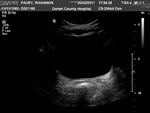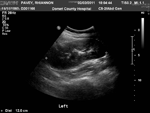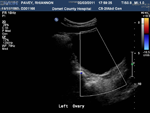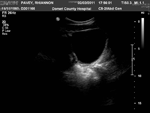Mayer-Rokitansky-Kuster-Hauser Syndrome in a 17-Year-Old Female
Mayer-Rokitansky-Kuster-Hauser (MRKH) syndrome affects at least 1 in 4500 female births.1 The syndrome consists of vaginal aplasia with other müllerian duct abnormalities. The characteristic feature of MRKH syndrome is congenital absence or underdevelopment of the upper vagina and uterus; it is rarely associated with unilateral renal agenesis, ectopia, or horseshoe kidney.
Introduction
Mayer-Rokitansky-Kuster-Hauser (MRKH) syndrome affects at least 1 in 4500 female births.1 The syndrome consists of vaginal aplasia with other mllerian duct abnormalities. The characteristic feature of MRKH syndrome is congenital absence or underdevelopment of the upper vagina and uterus; it is rarely associated with unilateral renal agenesis, ectopia, or horseshoe kidney. Other possible malformations include vertebral, otologic, and cardiac anomalies. MRKH syndrome is the second leading cause of primary amenorrhea.2,3
Case Report
A 17-year-old female presented with complaints of primary amenorrhea. She stated that she became sexually active at 16 years and had noted changes associated with puberty around 13 years of age. She has normal breast development, average height and weight, and normal arm span. The patient also has normal body hair distribution, including pubic and axillary hair. Pelvic examination showed her vulva, labia minora and majora, and clitoris as normal and well estrogenized. The vagina was found to be blindly ending, with the length of 7 cm.
Hormone profile included measurement of follicular stimulating hormone (FSH), luteinizing hormone (LH), estradiol, and 17-hydroxyprogesterone, which were all normal, indicating normal hypothalamic-pituitary-ovarian axis. An ultrasound scan of the abdomen and pelvis confirmed a blind vagina and poorly formed uterus. Both ovaries were normal in size and appearance. The single left pelvic kidney was within normal limits for size and appearance.
Genetic tests indicated normal (46, XX) female karyotype, which, obviously, is what differentiates MRKH syndrome from other genital tract development defects such as Turner syndrome (45,0X) and androgen insensitivity syndrome (46, XY).2,4
The clinical finding and anatomical developmental defects of this patient can be explained by MRKH syndrome.
Discussion
FIGURES





Ultrasound scan done via trans-vaginal route. Imaging indicates absence of uterus and presence of normal ovaries. (Click images to enlarge.)
Mllerian ducts are the primordia for the female internal reproductive system. The uterus, cervix, and upper two thirds of the vagina form from the fused caudal ends of the mllerian ducts. Total aplasia of mllerian duct abnormalities range from minor anatomic variations to the total aplasia known as MRKH syndrome.2
Some authors classify the syndrome in 2 types: type I is characterized by an isolated absence of the upper two thirds of the vagina; type II is associated with other malformations. Upper urinary tract malformations are found in about 40% of cases,1 including unilateral renal agenesis (23%-28%), ectopia of one or both kidneys (17%), renal hypoplasia (4%), and horseshoe kidney and hydronephrosis. Skeletal abnormalities are found in 10%, while auditory defects are found in 2% to 10% of cases.1,2,5
No genetic cause has been identified for MRKH syndrome, and it was initially considered as a sporadic anomaly. However, recently it has been described as a polygenic multifactorial inheritance. The risk of recurrence in one family with this type of inheritance is 1% to 2%.2,4
Depression, anxiety, anger, and isolation are the most prevalent psychological effects of MRKH syndrome. This is mainly due to intercourse and the infertility issues. The endocrine balance of MRKH syndrome patients’ FSH, LH, and 17-hydroxyprogesterone levels is normal and provides evidence of normal and functional ovaries. There is no external or endocrine sign of hyperandrogenism.2,3
Although transabdominal ultrasound has been recommended for the diagnosis of uterine agenesis, it may not provide a completely reliable picture in mllerian duct anomalies.1,2 Therefore, magnetic resonance imaging (MRI) provides excellent images of the internal female reproductive anatomy. For the correct identification of malformations associated with MRKH syndrome, MRI or a combination of clinical examination and ultrasound are equivalent.6
Treatment of MRKH syndrome may be surgical or nonsurgical. While there are various methods for lengthening the vagina, no current method guarantees complete patient satisfaction.7 Laparoscopy is not only useful for diagnosis of uterine malformations but also for assisted vaginoplasty.1,7 Assisted fertility techniques, including surrogacy, enable women without a uterus to have genetic offspring.
Add your comments to this interactive case study.
References:
References
Gupta NP, Ansari MS. Mayer-Rokitansky-Kuster-Hauser (MRKH) syndrome-a review. Indian J Urol. 2002; 18:111-116.
Morcel K, Camborieux L. Programme de Recherches sur les Aplasies Mulleriennes (PRAM), Daniel Guerrier, Mayer-Rokitansky-Küster-Hauser (MRKH) syndrome. Orphanet J Rare Dis. 2007; 2:13.
Quint EH, Smith YR. Primary amenorrhea in a teenager. Obstet Gynecol. 2006; 107:414-417.
Pandey B, Hamdi IM. Mayer-Rokitansky-Kuster-Hauser syndrome of Mullerian agenesis. Saudi Med J. 2003; 24:532-534.
Pittock ST, Babovic-Vuksanovic D, Lteif A. Mayer-Rokitansky-Kuster-Hauser anomaly and its associated malformations. Am J Med Genet A. 2005; 135: 314-316.
Lermann J, Mueller A, Wiesinger E et al. Comparison of different diagnostic procedures for the staging of malformations associated with Mayer-Rokitansky-Kuster-Hauser Syndrome. Fertil Steril. 2011 May 4. [Epub ahead of print]
Roberts CP, Haber MJ, Rock JA. Vaginal creation for mullerian agenesis. Am J Obstet Gynecol. 2001;185:1349-1353.
